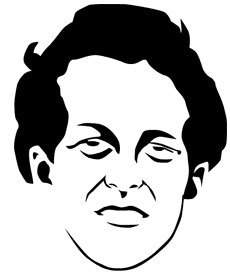

|


![]()
Babe Didrikson Zaharias
Zaharias, Mildred Ella Didrikson (1911-1956). Mildred Ella (Babe) Didrikson Zaharias, athlete, was born on June 26, 1911, in Port Arthur, Texas, the sixth of seven children of Norwegian immigrants Ole Nickolene and Hannah Marie (Olson) Didriksen. Ole Didriksen was a seaman and carpenter, and his wife was an accomplished skater in Norway. In 1915 the family moved to Beaumont, Texas, where the children, with the encouragement of both parents, became skilled performers on the rustic gymnasium equipment that their father built in the backyard. Mildred Didrikson, who changed the spelling of her surname, acquired her nickname during sandlot baseball games with the neighborhood boys, who thought she batted like Babe Ruth. A talented basketball player in high school, Didrikson was recruited during her senior year in 1930 to do office work at Employers Casualty Company of Dallas and to spark the company's semiprofessional women's basketball team, the Golden Cyclones. Between 1930 and 1932 she led the team to two finals and a national championship and was voted All-American each season. Her exceptional athletic versatility prompted Employers Casualty to expand its women's sports program beyond basketball. Didrikson represented the company as a one-woman team in eight of ten track and field events at the 1932 Amateur Athletic Union Championships. She placed in seven events, taking first place in five-shot put, javelin and baseball throws, eighty-meter hurdles, and long jump; she tied for first in the high jump and finished fourth in the discus throw. In three hours Didrikson singlehandedly amassed thirty points, eight more than the entire second-place team, and broke four world records. Her performances in the javelin throw, hurdles, and high jump qualified her to enter the 1932 Olympics, where she again broke world records in all three events. She won gold medals for the javelin and hurdles and, despite clearing the same height as the top finisher in the high jump, was awarded the silver medal because she went over the bar head first, a foul at that time.
Didrikson received a heroine's welcome on her return to Texas. She had started another basketball season with the Golden Cyclones when the Amateur Athletic Union disqualified her from amateur competition because her name appeared in an automobile advertisement. Her family was badly in need of money, and Didrikson turned professional to earn what she could from her status as a sports celebrity. Never hesitant to capitalize on her own abilities or to turn a profit from showmanship, she spent 1932-34 promoting and barnstorming. She did a brief stint in vaudeville playing the harmonica and running on a treadmill and pitched in some major league spring-training games; she also toured with a billiards exhibition, a men's and women's basketball team called Babe Didrikson's All-Americans, and an otherwise all-male, bearded baseball road team called the House of David. Since golf was one of the few sports that accommodated women athletes, Didrikson made up her mind to become a championship player, and between engagements she spent the spring and summer of 1933 in California taking lessons from Stan Kertes. Her first tournament was the Fort Worth Women's Invitational in November 1932; at her second, the Texas Women's Amateur Championship the following April, she captured the title. Complaints from more socially polished members of the Texas Women's Golf Association led the United States Association to rule her ineligible to compete as an amateur, thus disqualifying her from virtually all tournament play. Didrikson resumed the lucrative routine of exhibition tours and endorsements, impressing audiences with smashing drives that regularly exceeded 240 feet. She met George Zaharias, a well-known professional wrestler and sports promoter, when she qualified at the 1938 Los Angeles Open, a men's Professional Golfers' Association tournament. They were married on December 23, 1938, and Zaharias thereafter managed his wife's career. She regained her amateur standing in 1943 and went on to win seventeen consecutive tournaments, including the British Women's Amateur Championship (she was the first American to win it), before turning professional in 1947. The following year Didrikson helped found the Ladies Professional Golf Association in order to provide the handful of professional women golfers with a tournament circuit. She was herself the LPGA's leading money winner between 1949 and 1951. In 1950 the Associated Press voted her Woman Athlete of the Half-Century.
In April 1953 Didrikson underwent a colostomy to remove cancerous tissue. Despite medical predictions that she would never be able to play championship golf again, she was in tournament competition fourteen weeks after surgery, and the Golf Writers of America voted her the Ben Hogan Trophy as comeback player of the year. In 1954 she won five tournaments, including the United States Women's Open. Portrayed as a courageous survivor in the press, Didrikson played for cancer fund benefits and maintained her usual buoyant public persona, but in June 1955 she was forced to reenter John Sealy Hospitalqv at the University of Texas Medical Branch in Galveston for further diagnosis. Medical treatment was unable to contain the spreading cancer, and Didrikson spent much of the remaining fifteen months of her life in the hospital. In September 1955 she and her husband established the Babe Didrikson Zaharias Fund, which financed a tumor clinic at UTMB. She died at John Sealy Hospital on September 27, 1956, at the age of forty-five, and was buried in Beaumont. Didrikson's exuberant confidence, self-congratulatory manner, and cultivation of her celebrity status irritated some fellow athletes, but she was the most popular female golfer of her own time and since. She enjoyed playing to the gallery in her golf matches, and her wisecracks and exhibitions of virtuosity delighted spectators. She was voted Athlete of the Year by the Associated Press six times during her career. Between 1940 and 1950 she won every women's golf title, including the world championship (four times) and the United States Women's Open (three times). She established a national audience for women's golf and was the first woman ever to serve as a resident professional at a golf club. In 1955, a year before her death, she established the Babe Zaharias Trophy to honor outstanding female athletes.
BIBLIOGRAPHY: Current Biography, 1947. William Oscar Johnson and Nancy P. Williamson, "Whatta-Gal": The Babe Didrikson Story (Boston: Little, Brown, 1975). New York Times, September 28, 1956. Notable American Women: A Biographical Dictionary (4 vols., Cambridge, Massachusetts: Harvard University Press, 1971-80). Babe Didrikson Zaharias, This Life I've Led (New York: Barnes, 1955).
Susan E. Cayleff
"ZAHARIAS, MILDRED ELLA DIDRIKSON [BABE]."
The Handbook of Texas Online. <http://www.tshaonline.org/handbook/online/articles/view/ZZ/fza1.html>
[Accessed Tue Jul 11 10:53:51 2000 ].